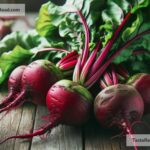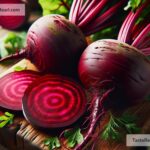Why Beets Are Often Used in Natural Food Coloring
Food lovers and health-conscious families around the world are becoming more aware of the ingredients in their meals and snacks. Many people are choosing natural alternatives to artificial food dyes, and one of the most popular options for creating vibrant reds is the humble beet. Whether you enjoy it in your salads, smoothies, or as a natural color enhancer in baked goods, beets are proving to be a versatile and healthy choice. But why are beets so often used in natural food coloring? Let’s explore the reasons in simple terms.
1. The Color Says It All
If you’ve ever chopped a beet, you know how powerful its color is. Beets are filled with pigments called betalains, which give them their rich, deep red or purple hue. These pigments stay visible even when the beets are cooked or processed. When extracted, this vibrant red color can be used to make foods look more appealing. It’s no wonder beets have become a top choice for adding natural color to a variety of foods, like candy, yogurt, soups, and even drinks.
Artificial food dyes come in a rainbow of colors, but many people are avoiding them because they can sometimes cause allergies or unwanted health effects. Beets offer a safe and healthy way to achieve a beautiful red or pink shade without relying on synthetic chemicals.
2. Beets are Safe and Healthy
Unlike artificial dyes, beet-based food coloring is completely natural. Beets are packed with vitamins, minerals, and antioxidants, which makes them not just a coloring agent but also a nutritious addition to food. Although the amount of beet extract used for coloring is small, it’s comforting to know that the source of the coloring is something wholesome.
Artificial dyes, like Red No. 40, have been linked to various health concerns such as hyperactivity in children and allergic reactions. Beet-based coloring is free from harmful additives and chemicals, making it a safer alternative for families who want to avoid these risks.
3. Environmentally Friendly
Making synthetic food dyes involves a complex chemical process that can leave a negative impact on the environment. In contrast, creating natural food coloring from beets involves simple, eco-friendly methods. Often, beet juice or powder is extracted directly from the vegetable without the need for harsh chemicals or heavy machinery. Since beets grow easily in many regions, they’re also a sustainable crop.
Using natural beet coloring helps reduce the demand for artificial dyes and supports a cleaner, greener planet. Companies and individuals looking to make environmentally friendly choices can benefit from this natural option.
4. Versatility in Food Applications
Beet-derived coloring isn’t just limited to one type of food. It works well in both sweet and savory recipes, as well as liquids and solids. The color can be adjusted depending on how concentrated the beet extract is, allowing cooks to create everything from pale pink desserts to bold red candies.
This versatility makes beet-based coloring ideal for bakers, chefs, and food manufacturers. It blends easily with other ingredients, doesn’t greatly alter the flavor, and works in a wide variety of recipes. For example, if you’re making a red velvet cake, beetroot powder will give it the rich red hue traditionally achieved with artificial dyes.
5. Safe for Various Diets
Beet-based food coloring suits many dietary restrictions. It’s suitable for vegans and vegetarians, as no animal products are involved in its creation. It’s also gluten-free, allergen-free, and often organic, making it perfect for people with sensitive dietary needs. In contrast, some artificial food dyes contain ingredients derived from petroleum or other chemicals, which might not align with certain food preferences or lifestyles.
Parents also love beets for their kid-friendly uses. Beet coloring can be used to brighten cookies, cupcakes, or even homemade playdough, all while being entirely safe for little ones to handle and eat.
6. It’s Been Used for Centuries
Beets are far from a recent food trend. People have been using them for centuries, both for their flavor and coloring properties. Ancient civilizations used beet juice to dye fabrics and create cosmetics. Over time, humans discovered that beets could also color food naturally, making it more appealing and enjoyable. Today, this timeless vegetable continues to serve as a trusted source of color in cooking and food production.
7. A Fun DIY Option
If you like experimenting in the kitchen, beet coloring is easy to make at home. You can create beet juice simply by blending fresh beets, or you can purchase beetroot powder from a health food store. This can be used to brighten frosting, dough, or even beverages. Making natural food coloring from beets is a great way to control what goes into your food and avoid unnecessary additives.
The Bottom Line
Beets have earned their place as a favorite for natural food coloring because of their vibrant color, safety, health benefits, and eco-friendly production methods. Their versatility and history of use make them a reliable and accessible option for home cooks and manufacturers alike. As more people turn to natural alternatives, beets prove that wholesome food can also be beautiful.
Next time you’re looking to add a splash of color to your food, consider reaching for beets—your health, the environment, and your taste buds will thank you!


